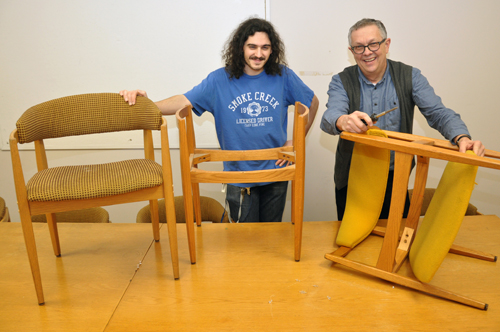
One department’s trash could be another department’s treasure, thanks to a new “furniture swap” website that launched in January. Old office desks, chairs and filing cabinets are now getting a new lease on life instead of ending up in a landfill.
Paul Caruso, a fifth-year student in physics and philosophy, came up with the idea for the website while working as a recycling coordinator for physical resources. “We’re looking at ways to reduce waste,” he says, adding that unwanted furniture was often donated to local charities or thrown out. “What can we capture to keep using on this campus? That’s the best practice.”
The website makes it easy for people to advertise their furniture by providing a description, including the number of items, dimensions, the material it’s made of and a photo. If someone on campus is interested in the furniture, physical resources staff will pick it up and deliver it for free.
“It’s an easy thing for people to be sustainable,” says Maurice Nelischer, director of sustainability. He points to a U of G department that threw away a large quantity of furniture last fall. “It was dated, it was old, but surely someone could have used it.” That’s the goal of the website: connecting unwanted furniture with someone who wants it.
He says the website offers a good alternative to buying new furniture because it helps departments save money while saving the environment. “Every department has a storage room of useless stuff; useless to them but valuable to somebody else maybe.” He estimates that discarded furniture accounts for about one per cent of the University’s total annual waste. “We think it’s a lot.”
Nelischer recently refurbished 30 chairs made in the 1970s. “It’s still good stuff,” he says. “It’s held up for 40 years.” Those chairs have outlived newer chairs he purchased for the foyer of the Landscape Architecture building several years ago, most of which are now broken because they weren’t designed to withstand the rigors of student use.
He repaired the hardwood frames of the older chairs and had them reupholstered at a cost of $40 per chair. “When you have mid-century modern furniture, it’s a neat thing to have as a vestige of those times,” he says. Many of the older chairs were made locally, he adds, but he acknowledges that even they will eventually need to be replaced.
Before the website was launched, the process of reusing furniture on campus was “haphazard,” says Nelischer. Ever since administrative staff were notified of the website, he adds, “It was amazing how many said they love the idea.”
Since U of G doesn’t currently have a storage facility for unwanted furniture, departments are encouraged to keep the furniture until someone else wants. If furniture on the website goes unclaimed, it will be available to anyone on campus before it’s donated to Habitat for Humanity’s ReStore.
Caruso says the website will help identify what he calls “repeat offenders”: the types of furniture that keep getting discarded. He encourages departments to regularly purge their office space of unwanted furniture, which frees the space for other uses.
If you have furniture that needs a new home, contact Nelischer at mnelisch@uoguelph.ca.
Other green initiatives on campus include the collection of several tons of coffee grounds from campus coffee shops each semester. The Guelph Centre for Urban Organic Farming uses the coffee grounds to enrich its soil. Physical resources also collects electronic and hazardous waste on campus. For more information, visit the Sustainability Office website.